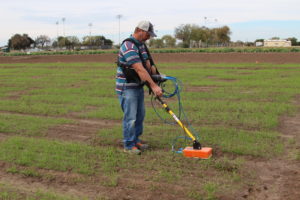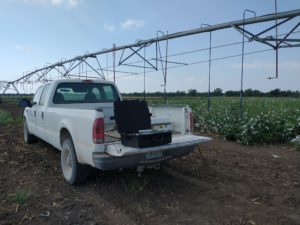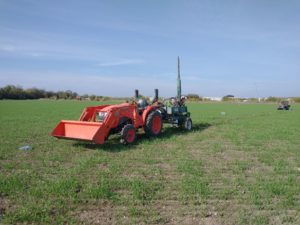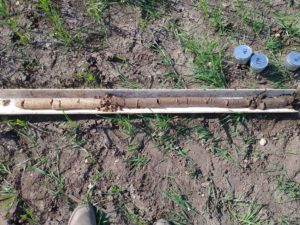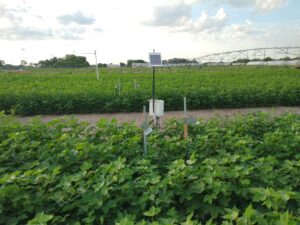Summary
Current Research
Our Agro-Ecology and Cropping Systems program focuses on the ecophysiological mechanisms of soil-plant-water interactions for improving water use efficiency and soil health in cropping systems. Our main research areas are:
- Characterization of plant traits for improved water acquisition, adaptation and resistance to abiotic and biotic stresses;
- Application of ground-based sensors for remote detection of soil, plant root and canopy features;
- Quantification of soil parameters that indicate microbial and root activities under natural and managed ecosystems; and
- Quantitative models that describe soil water movement, plant root water uptake in agricultural soils.
Recent Presentations
- “Plant water potentials: their components and rapid and remote measurement to detect crop water stress in field crops”. A seminar hosted by the department of Environmental Sciences at the University of Puerto Rico Rio Piedras. 10:00 am CST, February 20, 2025. (delivered virtually)
- “Crop Physiology and Agroecology at Texas A&M Uvalde”. The Agricultural Engineering Graduate Program, Federal University of Rondonópolis, Mato Grosso, Brazil. December 11, 2024.
- “Water Resources Science and Technology Fall Seminar Series: Dr. Xuejun Dong (Texas A&M AgriLife Research Center at Uvalde ).” Texas A&M University – San Antonio, (November 9, 2023). Videos. 15. https://digitalcommons.tamusa.edu/water_videos/15
- “Crop Physiology and Agroecology at Texas A&M Uvalde”. The Agricultural Engineering Graduate Program, Federal University of Rondonópolis, Mato Grosso, Brazil. December 11, 2024.
Drs. Tonny Silva, Adna Bonfim-Silva, and Thiago Duarte, and graduate students at the Agricultural Engineering Graduate Program, Federal University of Rondonópolis, Mato Grosso, Brazil.
- On February 23, 2021, Dr. Xuejun Dong gave a talk at the International Sesame Research Symposium hosted by Dr. Kimberly Cochran at Texas A&M AgriLife Extension. *Dr. Dong talk started at 56:52. https://drive.google.com/drive/folders/1eXJkbebDh07u8o_LrJ6dXvM8PpBJoFLJ?usp=sharing
Dr. Xuejun Dong’s online postings at zenodo.org (free downloading) Link
Shoot and Root Traits to Enhance Crop Growth
In the winter wheat varieties tested at the Uvalde center, the top two ‘picks’ were ‘TAM 305’ and ‘TAM 304’ out of 10 varieties evaluated. Two of the varieties: ‘TAM 112’ and ‘Fannin’ yielded the lowest, due to susceptibility to leaf rust infection. In relatively wet years, planting winter wheat under deficit irrigation or dry-land would not cause a significant yield loss in southwest Texas. Based on field tests conducted in Uvalde and Amarillo, we found a better way to predict leaf water use efficiency. Rather than evaluating the bulk leaf carbon isotopes, the team found leaf wax alkane concentration and compound-specific carbon and hydrogen isotopes best for predicting water use.
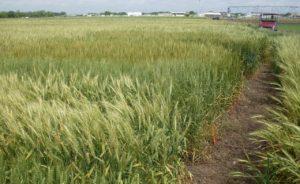
Our studies on corn and sorghum found after a two-year field study focused on the leaf and canopy traits that some of the modern corn genotypes achieved a water use efficiency that is 30% higher than sorghum genotypes when planted in the same field in southwest Texas. 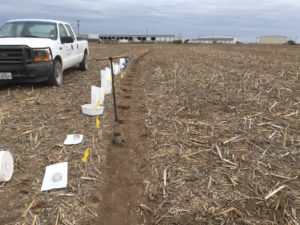
Recently, in a study, we did on cotton we found in a field performance test of 12 commercial cotton varieties in Uvalde that a 35% reduction in the amount of irrigation did not affect seed cotton yields, but reduced fiber quality, such as fiber strength, fiber length, and elongation. The diminished fiber quality was prevalent with increased leaf dry matter content rather than leaf osmotic potential.
Field Phenotyping for Crop Improvements
We obtained an initial success in detecting fine root biomass of winter wheat and energy cane using the ground penetrating radar (GPR) system attached with a 1600 MHz antenna. This progress provides hope for predicting crop fine root biomass remotely under field conditions.
In collaboration with wheat breeders, we are developing methods for predicting leaf rust infection rate using ground-based phenotyping methods. We demonstrated that canopy reflectance at red-edge band reflects the presence of leaf rust in winter wheat during the flowering stage.
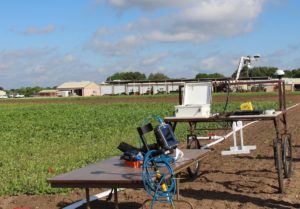
We are currently developing regression models to link the leaf water potential of field crops based on normalized difference vegetation index (NDVI) obtained from ground-based phenotyping tools. This will assist in crop improvement through rapid characterization of drought tolerance capacity of crop genotypes under field conditions.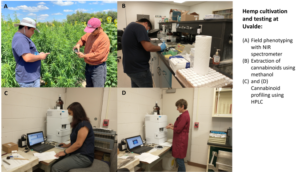
Soil Management to Improve Water Use Efficiency
In our studies on soil management, we have found that deficit irrigation in early growing stages for cotton can promote root growth and save 16% of irrigation water over five years without reducing cotton lint yield. In a long-term cropping system experiment, we found using strip-tillage resulted in an increase in cotton and corn crops. In a study of tomato plants planted in soils affected by salinity and sodicity we discovered that several soil quality guides, from soil electrical conductivity to aggregate stability and infiltration rates, improved over a period of four months. Our current study is incorporating winter cover crops into the cropping system with different tillage regimes to improve soil health and cash crop productivity.
Crop Modeling to Increase Crop Production Efficiency
Our study of crop modeling is deepening our understanding of the process of transpiration by linking stomatal conductance to canopy energy transfers for field crops. Additionally, we are identifying options for improving cropping system productivity by using the DSSAT-Cropping System Models under various scenarios of water/fertility management and crop rotations. This study is helping us to characterize water use patterns of major field crops, such as corn, cotton, wheat, and sesame, by measuring and modeling root zone processes that govern water movement and transfer under field conditions and develop optimal irrigation scheduling tool for field crops considering rainfall uncertainty.
Field measurements of soil water content, plant canopy temperature and net radiation help us develop irrigation scheduling models for increasing crop water use efficiency.
Dr. Xuejun Dong
Team Members
Dr. Uzair Ahmad – Postdoctoral Research Associate
Dr. Thiago Duarte – Visiting Scholar – Federal University of Rondonópolis, Brazil
Noemi Tortorici – Visiting Scholar – University of Palermo, Italy
Publications
Selected Publications (2020-2025):
- X. Dong, D. A. Mott, Q. Zhou, and B. M. McKnight. 2025. Does sample size of leaf osmotic potential significantly affect the evidence of its association with cotton yield? Journal of Arid Environments. 229, 105387. https://doi.org/10.1016/j.jaridenv.2025.105387
- J. Sunoj, V. S., X. Dong, M. V. Joshi, R. W. Jessup, D. I. Leskovar, and D. D. Baltensperger. 2025. Foliar gas exchange, morphology, and cannabinoid contents of three hemp varieties in southwest Texas. Agrosystems, Geosciences & Environment, e70101. https://doi.org/10.1002/agg2.70101
- G. F. Lima, T. F. Duarte, T. J. A. da Silva, E. M. Bonfim-Silva, X. Dong, L. A. M. Meneghetti, and A. S. C. Custódio. 2025. Determination of field capacity in Oxisol by the flux density method, Arya-Paris model and pressure chamber. Brazilian Journal of Agricultural and Environmental Engineering (Agriambi Journal). 29 (3): e283074.
- T. F. Duarte, E. M. Bonfim-Silva, T. J. A. da Silva, P. F. da Silva, L. A. M. Meneghetti, X. Dong, and M. de Oliveira Matosa. 2024. Construction and evaluation of an alternative tension infiltrometer in Oxisol under wood ash management. Brazilian Journal of Agricultural and Environmental Engineering (Agriambi Journal). 28 (12): e283076.
- K. Qin, X. Dong, and D. I. Leskovar. 2023. Improving tomato nitrogen use efficiency with lignite-derived humic substances. Scientia Horticulturae, 321: 112243. https://doi.org/10.1016/j.scienta.2023.112243
- J. Sunoj Valiaparambil Sebastian, X. Dong, C. Trostle, H. Pham, M. V. Joshi, R. W. Jessup, M. D. Burow, and T. L. Provin. 2023. Hemp agronomy: current advances, questions, challenges, and opportunities. Agronomy, 13, 475. https://doi.org/10.3390/agronomy13020475
- X. Dong, G. Feng, S. Sieckenius, and D. I. Leskovar. 2023. Effect of mustard cover crops on corn growth, yield and soil water storage in southwest Texas. Arid Land Research and Management. 37(2): 265-283. https://doi.org/10.1080/15324982.2022.2130114
- Dong, 2022. How to put plant root uptake into a soil water flow model. F1000Research 5,43 Revised version, https://doi.org/10.12688/f1000research.7686.2
- O. Hinson, C.B. Adams, X. Dong, Q. Xue, S. Thapa, G. Feng, E. Kimura, B. Pinchak, A. Somenahally, and A. M. H. Ibrahim. 2022. Path analysis of phenotypic factors associated with grain protein in dryland winter wheat. Journal of Crop Improvement. 36: 892-918. https://doi.org/10.1080/15427528.2022.2042882
- X. Dong, D. A. Mott and B. M. McKnight. 2022. Leaf osmotic potential and morphological traits of 43 cotton varieties growing in a rainfall gradient from southwest to central Texas – an update. In Boyd, S., Human, M., Krogman,L., and Sarkissian, A., editors, Proceedings of the 2022 Beltwide Cotton Conferences, pages 562-569, San Antonio Rivercenter. National Cotton Council of America.
- X. Dong, B. Peng, S. Sieckenius, R. Raman, M. M. Conley, D. I. Leskovar. 2021. Leaf water potential of field crops estimated using NDVI in ground-based remote sensing – opportunities to increase prediction precision. PeerJ 9:e12005 DOI 10.7717/peerj.12005
- X. Dong and D. A. Mott. 2021. Leaf osmotic potential and morphological traits of 43 cotton varieties growing in a rainfall gradient from southwest to central Texas. In Boyd, S., Human, M., Krogman,L., and Sarkissian, A., editors, Proceedings of the 2021 Beltwide Cotton Conferences, pages 193-197, Virtual. National Cotton Council of America.
- X. Dong, G. Feng, and I. Zemach. 2020. Using normalized difference vegetation index to estimate sesame drydown and seed yield. Journal of Crop Improvement. doi: 10.1080/15427528.2020.1846101.


